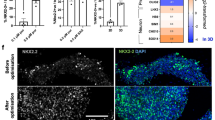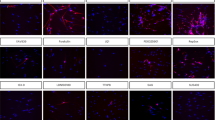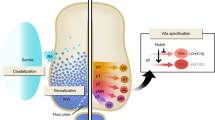Abstract
Lineage-restricted progenitors of the central nervous system (CNS) are not readily expandable because their mitotic competence is limited. Here we used retroviral overexpression of human telomerase reverse transcriptase (hTERT) to immortalize progenitors from human fetal spinal cord. The hTERT-immortalized cells divided in basic fibroblast growth factor (bFGF) expressed high telomerase activity, and gave rise to phenotypically restricted subpopulations of either glia or neurons. The latter included a prototypic line, hSC11V-TERT, that gave rise only to neurons. These included both chx10+ interneurons and Islet1+/Hb9+/ChAT+ motor neurons; the latter were recognized by green fluorescent protein (GFP) driven by the Hb9 enhancer. The neurons were postmitotic and achieved electrophysiologic competence. Upon xenograft to both fetal rat brain and injured adult spinal cord, they matured as neurons and survived for 6 months, with no evident tumorigenesis. The cells have survived >168 doublings in vitro, with karyotypic normalcy and without replicative senescence. hTERT overexpression thus permits the generation of progenitor lines able to give rise to phenotypically restricted neurons.
This is a preview of subscription content, access via your institution
Access options
Subscribe to this journal
Receive 12 print issues and online access
$209.00 per year
only $17.42 per issue
Buy this article
- Purchase on Springer Link
- Instant access to full article PDF
Prices may be subject to local taxes which are calculated during checkout






Similar content being viewed by others
References
Harley, C., Futcher, A. & Greider, C. Telomeres shorten during aging of human fibroblasts. Nature 345, 458–460 (1990).
Allsopp, R. et al. Telomere length predicts replicative capacity of human fibroblasts. Proc. Natl. Acad. Sci. USA 89, 10114–10118 (1992).
Wright, W., Piatyszek, M., Rainey, W., Byrd, W. & Shay, J. Telomerase activity in human germline and embryonic tissues and cells. Dev. Genetics 18, 173–179 (1996).
Ulaner, G. & Giudice, L. Developmental regulation of telomerase activity in human fetal tissues during gestation. Mol. Human Reprod. 3, 769–773 (1997).
Ostenfeld, T. et al. Human neural precursor cells express low levels of telomerase in vitro and show diminishing cell proliferation with extensive axonal outgrowth following transplantation. Exp. Neurol. 164, 215–226 (2000).
Bodnar, A.G. et al. Extension of life-span by introduction of telomerase into normal human cells [see comments]. Science 279, 349–352 (1998).
Jiang, X.R. et al. Telomerase expression in human somatic cells does not induce changes associated with a transformed phenotype. Nat. Genet. 21, 111–114 (1999).
Morales, C. et al. Absence of cancer-associated changes in human fibroblasts immortalized with telomerase. Nat. Genet. 21, 115–118 (1999).
Keyoung, H.M. et al. Specific identification, selection and extraction of neural stem cells from the fetal human brain. Nat. Biotechnol. 19, 843–850 (2001).
Morgenstern, J.P. & Land, H. Advanced mammalian gene transfer: high titre retroviral vectors with multiple drug selection markers and a complementary helper-free packaging cell line. Nucleic Acids Res. 25, 3587–3596 (1990).
Wright, W.E., Shay, J.W. & Piatyszek, M.A. Modifications of a telomeric repeat amplification protocol (TRAP) result in increased reliability, linearity and sensitivity. Nucleic Acids Res. 23, 3794–3795 (1995).
Holt, S.E., Wright, W.E. & Shay, J.W. Regulation of telomerase activity in immortal cell lines. Mol. Cell Biol. 16, 2932–2939 (1996).
Kang, J., Jiang, L., Goldman, S.A. & Nedergaard, M. Astrocyte-mediated potentiation of inhibitory synaptic transmission. Nat. Neurosci. 1, 683–692. (1998).
Tse, F.W., Fraser, D.D., Duffy, S. & MacVicar, B.A. Voltage-activated K+ currents in acutely isolated hippocampal astrocytes. J. Neurosci. 12, 1781–1788 (1992).
Briscoe, J., Pierani, A., Jessell, T. & Ericson, J. A homeodomain protein code specifies progenitor cell identity and neuronal fate in the ventral neural tube. Cell 101, 435–445 (2000).
Arber, S. et al. Requirement for the homeobox gene Hb9 in the consolidation of motor neuron identity. Neuron 23, 659–674 (1999).
Ericson, J., Morton, S., Kawakami, A., Roelink, H. & Jessell, T.M. Two critical periods of Sonic Hedgehog signaling required for the specification of motor neuron identity. Cell 87, 661–673 (1996).
Wichterle, H., Lieberam, I., Porter, J. & Jessell, T. Directed differentiation of embryonic stem cells into motor neurons. Cell 110, 385–397 (2002).
Oh, S., Song, Y., Kim, U., Yim, J. & Kim, T. In vivo and in vitro analyses of myc for differential promoter activities of the hTERT gene in normal and tumor cells. Biochem. Biophys. Res. Comm. 263, 361–365 (1999).
Wang, J., Hannon, G.J. & Beach, D.H. Risky immortalization by telomerase. Nature 405, 755–756 (2000).
Wei, W., Jobling, W., Chen, W., Hahn, W. & Sedivy, J. Abolition of cyclin-dependent kinase inhibitor p16Ink4a and p21Cip1/Waf1 functions permits Ras-induced anchorage-independent growth in telomerase-immortalized human fibroblasts. Mol. Cell Biol. 23, 2859–2870 (2003).
Brustle, O. et al. Chimeric brains generated by intraventricular transplantation of fetal human brain cells into embryonic rats. Nat. Biotechnol. 16, 1040–1044 (1998).
Basso, D.M., Beattie, M. & Bresnahan, J. Graded histological and locomotor outcomes after spinal cord contusion using the NYU weight-drop device versus transection. Exp. Neurol. 139, 244–256 (1996).
Young, W., Tomasula, J., DeCrescito, V., Flamm, E.S. & Ransohoff, J. Vestibulospinal monitoring in experimental spinal trauma. J. Neurosurg. 52, 64–72 (1980).
Teng, Y. et al. Functional recovery following traumatic spinal cord injury mediated by a unique polymer scaffold seeded with neural stem cells. Proc. Natl. Acad. Sci. USA 99, 3024–3029 (2002).
Feany, M.B., Lee, S., Edwards, R.H. & Buckley, K.M. The synaptic vesicle protein SV2 is a novel type of transmembrane transporter. Cell 70, 861–867 (1992).
Barber, R.P., Vaughn, J.E. & Roberts, E. The cytoarchitecture of GABAergic neurons in rat spinal cord. Brain Res. 238, 305–328 (1982).
Rao, M. & Anderson, D. Immortalization and controlled in vitro differentiation of murine multipotent neural crest stem cells. J. Neurobiol. 32, 722–746 (1997).
Rao, M.S. Multipotent and restricted precursors in the central nervous system. Anat. Rec. 257, 137–148 (1999).
Windrem, M. et al. Purified fetal human oligodendrocyte progenitor cells can substantially remyelinate the forebrain of congenitally dysmyelinated shiverer mouse. Nat. Med. 9, 439–445 (2004).
Sawamoto, K. et al. Generation of dopaminergic neurons in the adult brain from mesencephalic precursor cells labeled with a nestin-GFP transgene. J. Neurosci. 21, 3895–3903 (2001).
Wang, S. et al. Isolation of neuronal precursors by sorting embryonic forebrain transfected with GFP regulated by the T alpha 1 tubulin promoter. Nat. Biotechnol. 16, 196–201 (1998).
Roy, N.S. et al. Identification, isolation and enrichment of oligodendrocyte progenitor cells from the adult human subcortical white matter. J. Neuroscience 19, 9986–9995 (1999).
Roy, N.S. et al. In vitro neurogenesis by progenitor cells isolated from the adult human hippocampus. Nat. Med. 6, 271–277 (2000).
Fu, W., Lu, C. & Mattson, M. Telomerase mediates the cell survival-promoting actions of BDNF and secreted APP in developing hippocampal neurons. J. Neurosci. 22, 10710–10719 (2002).
Zhang, P., Chan, S., Fu, W., Mendoza, M. & Mattson, M. TERT suppresses apoptosis at a premitochondrial step by a mechanism requiring reverse transcriptase activity and 14-3-3 protein-binding ability. FASEB J. 17, 767–769 (2003).
Gorbunova, V. & Seluanov, A. Telomerase as a growth promoting factor. Cell Cycle 2, 534–537 (2003).
Murasawa, S. et al. Constitutive hTERT expression enhances regenerative properties of endothelial progenitor cells. Circulation 106, 1133–1139 (2002).
Nunes, M.C. et al. Identification and isolation of multipotential neural progenitor cells from the subcortical white matter of the adult human brain. Nat. Med. 9, 439–447 (2003).
Ostenfeld, T. et al. Human neural precursor cells express low levels of telomerase in vitro and show diminishing cell proliferation with extensive axonal outgrowth following transplantation. Exp. Neurol. 164, 215–226 (2000).
Kim, N. et al. Specific association of human telomerase activity with immortal cells and cancer. Science 266, 2011–2015 (1994).
Sherr, C. & DePinho, R. Cellular senescence: mitotic clock or culture shock? Cell 18, 407–410 (2000).
Todaro, G., Habel, K. & Green, H. Antigenic and cultural properties of cells doubly transformed by polyoma virus and SV40. Virology 27, 179–185 (1965).
Kirschenbaum, B. et al. In vitro neuronal production and differentiation by precursor cells derived from the adult human forebrain. Cerebral Cortex 4, 576–589 (1994).
Pincus, D., Goodman, R., Fraser, R., Nedergaard, M. & Goldman, S. Neural stem and progenitor cells: a strategy for gene therapy and brain repair. Neurosurgery 42, 858–868 (1998).
Acknowledgements
Supported by Project ALS and the Christopher Reeve Paralysis Foundation. H.M.K is supported by the Abby Rockefeller Mauze Medical Scientist Fellowship, The Iris L. and Leverett S. Woodworth Medical Scientist Fellowship and NIGMS GM07739. We thank Tom Jessell for the Hb9 9 kb promoter, H. Okano and A. Kawaguchi for the hsp68 promoter, Greg Caporaso for assistance in the TRAP assay, Fraser Sim for his advice and expertise in qPCR, Takahiro Takano for assistance in calcium imaging, and Li Jiang for assistance with patch clamp analysis. We are also grateful to Melissa Kujawski for technical assistance, Brad Poulos of the Fetal Tissue Resource Bank of the Albert Einstein College of Medicine and Geron Corp. for providing the retroviral pBABE-hTERT vector.
Author information
Authors and Affiliations
Corresponding author
Ethics declarations
Competing interests
M.C. is an employee of Geron.
Supplementary information
Rights and permissions
About this article
Cite this article
Roy, N., Nakano, T., Keyoung, H. et al. Telomerase immortalization of neuronally restricted progenitor cells derived from the human fetal spinal cord. Nat Biotechnol 22, 297–305 (2004). https://doi.org/10.1038/nbt944
Received:
Accepted:
Published:
Issue Date:
DOI: https://doi.org/10.1038/nbt944
This article is cited by
-
A prospect of cell immortalization combined with matrix microenvironmental optimization strategy for tissue engineering and regeneration
Cell & Bioscience (2019)
-
Conditionally immortalized stem cell lines from human spinal cord retain regional identity and generate functional V2a interneurons and motorneurons
Stem Cell Research & Therapy (2013)
-
DETA/NONOate, a nitric oxide donor, produces antidepressant effects by promoting hippocampal neurogenesis
Psychopharmacology (2008)



